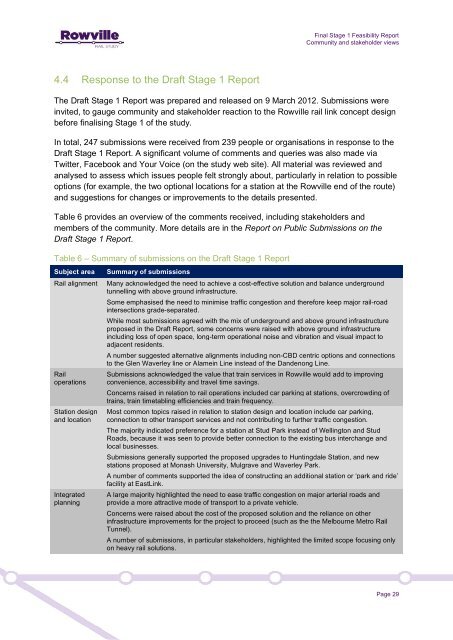Rowville-Rail-Study-Final-Stage-1-Report-FINAL
Rowville-Rail-Study-Final-Stage-1-Report-FINAL
Rowville-Rail-Study-Final-Stage-1-Report-FINAL
You also want an ePaper? Increase the reach of your titles
YUMPU automatically turns print PDFs into web optimized ePapers that Google loves.
4.4 Response to the Draft <strong>Stage</strong> 1 <strong>Report</strong><br />
<strong>Final</strong> <strong>Stage</strong> 1 Feasibility <strong>Report</strong><br />
Community and stakeholder views<br />
The Draft <strong>Stage</strong> 1 <strong>Report</strong> was prepared and released on 9 March 2012. Submissions were<br />
invited, to gauge community and stakeholder reaction to the <strong>Rowville</strong> rail link concept design<br />
before finalising <strong>Stage</strong> 1 of the study.<br />
In total, 247 submissions were received from 239 people or organisations in response to the<br />
Draft <strong>Stage</strong> 1 <strong>Report</strong>. A significant volume of comments and queries was also made via<br />
Twitter, Facebook and Your Voice (on the study web site). All material was reviewed and<br />
analysed to assess which issues people felt strongly about, particularly in relation to possible<br />
options (for example, the two optional locations for a station at the <strong>Rowville</strong> end of the route)<br />
and suggestions for changes or improvements to the details presented.<br />
Table 6 provides an overview of the comments received, including stakeholders and<br />
members of the community. More details are in the <strong>Report</strong> on Public Submissions on the<br />
Draft <strong>Stage</strong> 1 <strong>Report</strong>.<br />
Table 6 – Summary of submissions on the Draft <strong>Stage</strong> 1 <strong>Report</strong><br />
Subject area Summary of submissions<br />
<strong>Rail</strong> alignment Many acknowledged the need to achieve a cost-effective solution and balance underground<br />
tunnelling with above ground infrastructure.<br />
<strong>Rail</strong><br />
operations<br />
Station design<br />
and location<br />
Integrated<br />
planning<br />
Some emphasised the need to minimise traffic congestion and therefore keep major rail-road<br />
intersections grade-separated.<br />
While most submissions agreed with the mix of underground and above ground infrastructure<br />
proposed in the Draft <strong>Report</strong>, some concerns were raised with above ground infrastructure<br />
including loss of open space, long-term operational noise and vibration and visual impact to<br />
adjacent residents.<br />
A number suggested alternative alignments including non-CBD centric options and connections<br />
to the Glen Waverley line or Alamein Line instead of the Dandenong Line.<br />
Submissions acknowledged the value that train services in <strong>Rowville</strong> would add to improving<br />
convenience, accessibility and travel time savings.<br />
Concerns raised in relation to rail operations included car parking at stations, overcrowding of<br />
trains, train timetabling efficiencies and train frequency.<br />
Most common topics raised in relation to station design and location include car parking,<br />
connection to other transport services and not contributing to further traffic congestion.<br />
The majority indicated preference for a station at Stud Park instead of Wellington and Stud<br />
Roads, because it was seen to provide better connection to the existing bus interchange and<br />
local businesses.<br />
Submissions generally supported the proposed upgrades to Huntingdale Station, and new<br />
stations proposed at Monash University, Mulgrave and Waverley Park.<br />
A number of comments supported the idea of constructing an additional station or ‘park and ride’<br />
facility at EastLink.<br />
A large majority highlighted the need to ease traffic congestion on major arterial roads and<br />
provide a more attractive mode of transport to a private vehicle.<br />
Concerns were raised about the cost of the proposed solution and the reliance on other<br />
infrastructure improvements for the project to proceed (such as the the Melbourne Metro <strong>Rail</strong><br />
Tunnel).<br />
A number of submissions, in particular stakeholders, highlighted the limited scope focusing only<br />
on heavy rail solutions.<br />
Page 29


